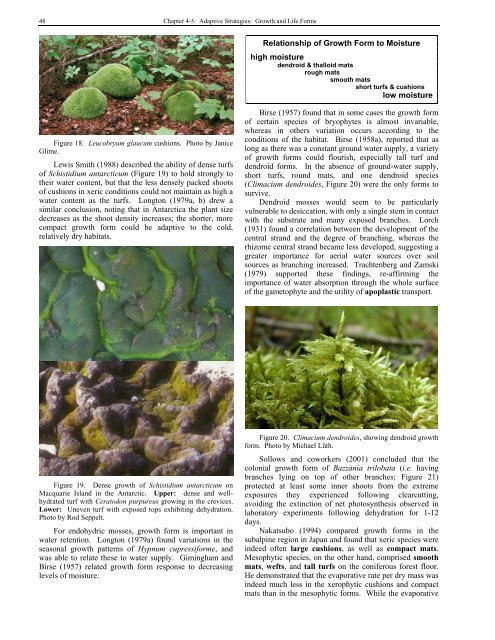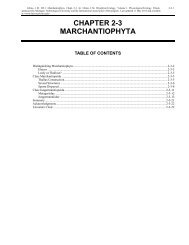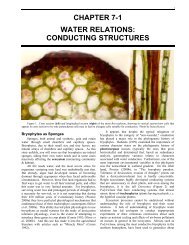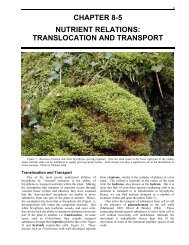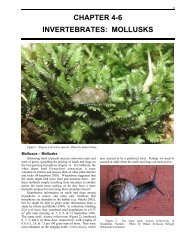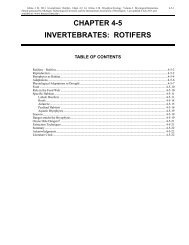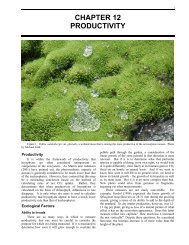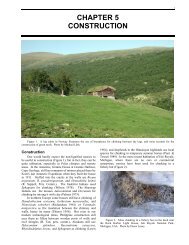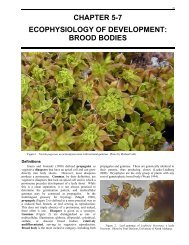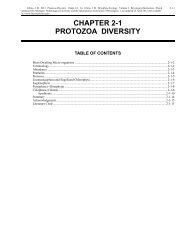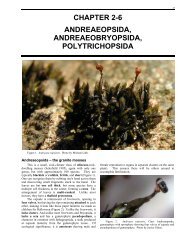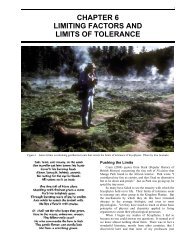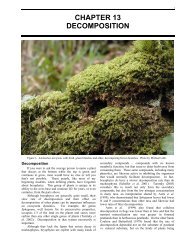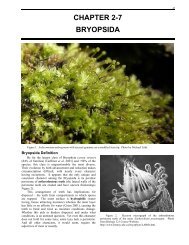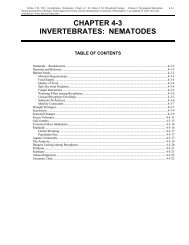Chapter 4-5: Adaptive Strategies - Bryophyte Ecology
Chapter 4-5: Adaptive Strategies - Bryophyte Ecology
Chapter 4-5: Adaptive Strategies - Bryophyte Ecology
You also want an ePaper? Increase the reach of your titles
YUMPU automatically turns print PDFs into web optimized ePapers that Google loves.
48 <strong>Chapter</strong> 4-5: <strong>Adaptive</strong> <strong>Strategies</strong>: Growth and Life Forms<br />
Figure 18. Leucobryum glaucum cushions. Photo by Janice<br />
Glime.<br />
Lewis Smith (1988) described the ability of dense turfs<br />
of Schistidium antarcticum (Figure 19) to hold strongly to<br />
their water content, but that the less densely packed shoots<br />
of cushions in xeric conditions could not maintain as high a<br />
water content as the turfs. Longton (1979a, b) drew a<br />
similar conclusion, noting that in Antarctica the plant size<br />
decreases as the shoot density increases; the shorter, more<br />
compact growth form could be adaptive to the cold,<br />
relatively dry habitats.<br />
Figure 19. Dense growth of Schistidium antarcticum on<br />
Macquarie Island in the Antarctic. Upper: dense and wellhydrated<br />
turf with Ceratodon purpureus growing in the crevices.<br />
Lower: Uneven turf with exposed tops exhibiting dehydration.<br />
Photo by Rod Seppelt.<br />
For endohydric mosses, growth form is important in<br />
water retention. Longton (1979a) found variations in the<br />
seasonal growth patterns of Hypnum cupressiforme, and<br />
was able to relate these to water supply. Gimingham and<br />
Birse (1957) related growth form response to decreasing<br />
levels of moisture:<br />
Relationship of Growth Form to Moisture<br />
high moisture<br />
dendroid & thalloid mats<br />
rough mats<br />
smooth mats<br />
short turfs & cushions<br />
low moisture<br />
Birse (1957) found that in some cases the growth form<br />
of certain species of bryophytes is almost invariable,<br />
whereas in others variation occurs according to the<br />
conditions of the habitat. Birse (1958a), reported that as<br />
long as there was a constant ground water supply, a variety<br />
of growth forms could flourish, especially tall turf and<br />
dendroid forms. In the absence of ground-water supply,<br />
short turfs, round mats, and one dendroid species<br />
(Climacium dendroides, Figure 20) were the only forms to<br />
survive.<br />
Dendroid mosses would seem to be particularly<br />
vulnerable to desiccation, with only a single stem in contact<br />
with the substrate and many exposed branches. Lorch<br />
(1931) found a correlation between the development of the<br />
central strand and the degree of branching, whereas the<br />
rhizome central strand became less developed, suggesting a<br />
greater importance for aerial water sources over soil<br />
sources as branching increased. Trachtenberg and Zamski<br />
(1979) supported these findings, re-affirming the<br />
importance of water absorption through the whole surface<br />
of the gametophyte and the utility of apoplastic transport.<br />
Figure 20. Climacium dendroides, showing dendroid growth<br />
form. Photo by Michael Lüth.<br />
Sollows and coworkers (2001) concluded that the<br />
colonial growth form of Bazzania trilobata (i.e. having<br />
branches lying on top of other branches; Figure 21)<br />
protected at least some inner shoots from the extreme<br />
exposures they experienced following clearcutting,<br />
avoiding the extinction of net photosynthesis observed in<br />
laboratory experiments following dehydration for 1-12<br />
days.<br />
Nakatsubo (1994) compared growth forms in the<br />
subalpine region in Japan and found that xeric species were<br />
indeed often large cushions, as well as compact mats.<br />
Mesophytic species, on the other hand, comprised smooth<br />
mats, wefts, and tall turfs on the coniferous forest floor.<br />
He demonstrated that the evaporative rate per dry mass was<br />
indeed much less in the xerophytic cushions and compact<br />
mats than in the mesophytic forms. While the evaporative


